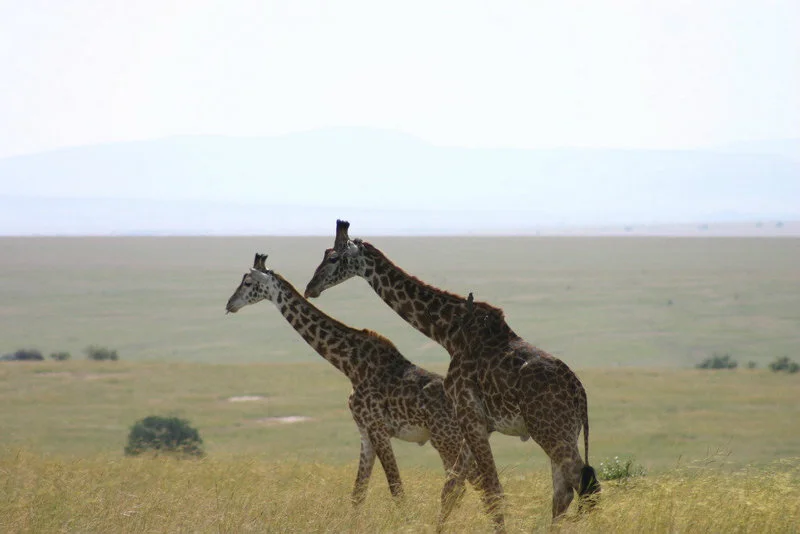 There are moments in life one never forgets. Experiences that change a person forever. For me, the second day in the Masai Mara did just that. If anything, this is the day that I fell in love with Africa.
There are moments in life one never forgets. Experiences that change a person forever. For me, the second day in the Masai Mara did just that. If anything, this is the day that I fell in love with Africa.
Forward: I wrote this blog back in January of 2012 shortly after my first visit to Africa. Using my journal as a reference, I recounted all of the amazing experiences during my second day in Kenya’s Masai Mara. Now having found it in the blog archives, I’m finally thrilled to be able to share it with all of you.

Today I was more determined than ever to complete the “Big Five” checklist. We had still not seen lion, leopard, or rhino.

We didn’t have to drive far to find our first pair of animals. Black-backed Jackals are quite common in the Mara and form unique pair bonds until one mate dies.

Black-backs are the most aggressive of the jackals found in Africa and regularly scavenge kills alongside lions and hyenas. Still they have to watch out for predators; leopards who have a known preference for dog meat, commonly prey on adults.

Once again, this is for you birders out there! This is a Helmeted Guineafowl.

Everyone in the Mara was on the lookout for Simba. No lions had been seen the day before and many of us were starting to get anxious.

I am proud to say that I was the first person to spot the lions! I remember yelling at our driver James: “Lions, Lions, Lions!”

I could not believe it. My first wild lions. James then explained that these lions were part of the Ridge Pride; made famous by BBC’s Big Cat Diary. I had never been so starstuck in my entire life!

Looking back at the pictures now, I can see how thin these lions actually were. The unusually long grass made it difficult for predators to scan the Mara for prey.

This site reminded me of my emus back at home! Pictured is their close relative, the Ostrich.

This is a Coke’s Hartebeest. They once were Africa’s widest-ranging antelope: Now their numbers are greatly reduced due to habitat loss, livestock, and poaching.

Want to know what animal we observed the longest? You’re taking a look at it! The reason behind this was no one (including our resident bird experts) had seen anything like it. We all agreed it was a snake eagle of some sort.

On our way to breakfast we spotted a lone hyena. On TV you generally see them only in clans, but in reality they spend a great deal of their time individually patrolling their clan’s territory.

Could life get any better? Sipping tea in the Mara. We had a great breakfast by Rhino Ridge where I can clearly remember not being able to stroll far from the vehicle because of lions and hyenas.

The tall grass made it extremely difficult to distinguish between animal species. Nine times out of ten the “hyena” turned out to be a warthog. This time we were lucky.

Some veteran visitors to the Mara were quite concerned about the giraffe population. There just didn’t seem to be any around. You can imagine how happy we were to find this one! As sad as it is, giraffes in the Masai Mara have declined by over 70%.

The reason behind their decline is competition with cattle grazing inside the reserve. Although it is illegal, scientists claim that cattle grazing has increased by more than 1,100% in the Masai Mara.

Truly remarkable; I couldn’t imagine an Africa without giraffes. As we were enjoying our close encounter with the herd our driver James all of a sudden yelled: “We need to go!” “Sit down everyone.” “There’s a rhino!!!”

How incredible! James found one of the only 20-30 Black Rhinos left in the Masai Mara. Considering the reserve is the size of Rhode Island, it is like finding a needle in a haystack.

The rhinoceroses decline is no mystery. Beginning in the 1970’s the demand for their horn made it more precious than gold. Poachers eliminated entire populations; reducing their numbers to only a few thousand.

If you plan on seeing a rhino in the Mara, you probably won’t. They are extremely rare and the ones who get accustomed to vehicles often become an easy target for poachers.

In a matter of minutes as fast as the rhino appeared, it soon disappeared into the bush. I was amazed at how such a large creature could just “dissolve” right in front of my eyes. Unfortunately, scientists predict this animal will more than likely become extinct within our lifetime.
To see the footage visit this link: http://www.kivitv.com/goodmorningidaho/146981255.html

As we approached the Mara River, we continually saw Topi on mounds. Territorial and non-territorial individuals use these mounds frequently as a sign of dominance as well to scan the landscape for predators.

The Topi's unique narrow muzzle and mobile lips allow it to feed upon the freshest and greenish grass. It was no wonder we saw so many: The Mara had received quite a bit of rain making the vegetation flourish.

On the way to the Mara River in a small elongated pool I spotted a baby Nile Crocodile!!! Mind you that we were in a safari vehicle driving several feet away. For some reason I have a knack for spotting crocodiles or Mamba as they like to call it in the Mara. Can you find it?

As we approached the Mara River, you could see how eroded the banks were due to the 1.5 million animals that cross it every year. This was a famous wildebeest crossing point; part of one of the greatest spectacles on earth.
 Basking on the banks were giant Nile Crocodiles!!! This modern-day-dinosaur outweighs all of the big cats and is arguably the most voracious predator.
Basking on the banks were giant Nile Crocodiles!!! This modern-day-dinosaur outweighs all of the big cats and is arguably the most voracious predator.

With over two tons of protective mother, this baby hippo is completely safe living amongst giant crocodiles.

There are no restrooms on the Mara. To go, you have to pick a safe place, hop out of the safari vehicle, and hurry! I found it so interesting that our driver James never let us out if there weren’t warthogs around. He said that if there were warthogs, we would be safe. They have great senses and can detect predators.

Soon after I noticed vultures circling ahead. Dr. Virani always told us that vultures in the sky were a great indication of a kill.

We are not the only animals that do this. Lions, hyenas, and other scavengers depend on vultures to find carcasses. This hyena was headed in the same direction as us.

The hyena passed right by our vehicle. It was so close I honestly could have reached out and touched it.

The vultures led us right to an unusual, fairly stripped clean carcass. My first thought was what in the world was it? It turns out this was a 2-3 day old hippo carcass.

This was Africa. It was one of the most defining moments of my life and truly changed me forever. No words, pictures, or videos can describe this very moment. I instantly knew why so many people were transfixed by the Masai Mara.

Scavengers like this African White-backed Vulture are so important for the African ecosystem. They often get such a bad wrap, but in reality if we didn’t have them, there would be no Africa. It would be completely taken over by carcases and disease.

There wasn’t much left of the hippo but the skin. Ironically enough hyenas utilize carcasses more efficiently than any other predator in Africa. They can completely digest skin, fur, bones, and hooves within 24 hours.

The Masai Mara has lost over 70% of its vultures to poisoning, habitat loss, and persecution. In East Africa alone six out of the eight species are facing an extinction threat. Education is the number way we are going to save vultures for future generations.

Vultures aren’t the only animals that are threatened. Large carnivores like hyenas are also facing the same fate. As Africa’s population increases, there are more human and animal conflicts.

Directly behind us there was a young male lion. Several years ago lion populations numbered over 400,000 in Africa. Now there are only a staggering 20,000 left in all of Africa.

James later explained that these lions were part of the Serena Pride. Their pride leaders Notch and sons (famous for starring in Disney’s African Cats) were killing hippos at the time and were probably responsible for the death of the hippo.

Never in my life had I been surrounded by so many different animals. In front of us was a lone bull elephant, hippo, and crocodile. To our left was the carcass, behind that was the lion pride, to the right was a herd of buffalo, and far off in the distance was a herd of giraffe. I was in heaven.

Unlike the family of elephants we say the day prior, male elephants (like this one) live alone or in bachelor herds.

We had checked off all of the animals belonging to the “Big Five” except the leopard. I was determined to find one. Here we are literally in the middle of Smelly Crossing looking for a famous leopard named Olive.

On the way we spotted another lone bull elephant.

This could not have been better leopard territory. Still no leopard.

As the sun was beginning to set, we had the amazing opportunity of photographing these roosting vultures.

The second day on the Mara could not have gone better. It was more than I had ever expected and truly changed my life. My time in Africa though was slowly dwindling. The clock was ticking. I had less than a day left in the Mara and I was determined to see a leopard...
To watch the “Africa Blooper” reel visit this link: http://www.youtube.com/watch?v=QvRSiKZwGQg
First and foremost, I have to give special thanks to Dr. Munir Virani from the Peregrine Fund for organizing and setting up this amazing opportunity. I also would like to thank Dr. Marc Bechard from Boise State University for accompanying us on the adventure. I also have to give thanks to Matt McDonald; without him the footage and these amazing pictures would not exist. Thanks buddy! Last but not least I have to give credit to Richard D. Este's book The Safari Companion. It was a fantastic guide that I used religiously during my stay in Africa.
Afterword: That trip truly did change my life. Although we never saw a leopard the next day, it gave me inspiration to return. Upon arriving back in the states I was determined to find a way to get back to Africa. After doing countless hours of research and writing proposals, my dream became a reality. In late August of 2012 I returned to the Masai Mara during the Great Migration. I teamed up with Dr. Munir Virani and began filming “Through the Eyes of a Vulture;” a documentary about the plight of East Africa’s vultures. The documentary is set to premiere in the spring of 2013.





















































































































